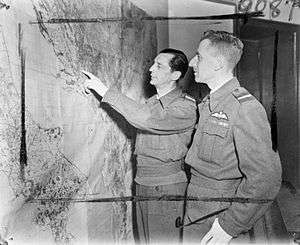William Elliot (RAF officer)
Air Chief Marshal Sir William Elliot, GCVO, KCB, KBE, DFC & Bar (3 June 1896 – 27 June 1971) was a senior Royal Air Force commander.
Sir William Elliot | |
|---|---|
 William Elliott as Air Officer Commanding RAF Gibraltar during the Second World War | |
| Born | 3 June 1896 |
| Died | 27 June 1971 (aged 75) |
| Allegiance | United Kingdom |
| Service/ | British Army (1915–18) Royal Air Force (1918–54) |
| Years of service | 1915–54 |
| Rank | Air Chief Marshal |
| Commands held | RAF Fighter Command (1947–49) Balkan Air Force (1944–45) RAF Gibraltar (1944) RAF Middle Wallop (1941) No. 501 Squadron (1932–37) |
| Battles/wars | First World War Second World War |
| Awards | Knight Grand Cross of the Royal Victorian Order Knight Commander of the Order of the Bath Knight Commander of the Order of the British Empire Distinguished Flying Cross & Bar Order of St. Vladimir, 4th Class with Sword and Bow (Russia) Order of St. George, 4th Class (Russia) Commander of the Legion of Merit (United States) Grand Cross of the Order of the Phoenix (Greece) |
RAF career

Educated at Tonbridge School, Elliot joined the Army Service Corps in 1915 and then transferred to the Royal Flying Corps in 1917.[1]
On 30 July 1919 Elliot, then a Captain, crashed behind enemy lines while fighting the Bolshevik forces during the North Russia Intervention. Another plane crewed by Lt John Mitchell and Captain Walter Anderson landed and picked up Elliot and flew him and his observer back to the base.[2] He was appointed Officer Commanding No. 501 Squadron in 1932 before becoming Assistant Secretary to Committee of Imperial Defence in 1937 and being made Assistant Secretary of the War Cabinet Secretariat in 1939.[1] He served in the Second World War as Officer Commanding RAF Middle Wallop and as a member of the Air Staff responsible for Night Defences at Headquarters RAF Fighter Command in 1941 and then as Director of Plans at the Air Ministry in 1942.[1] He continued has war service as Air Officer Commanding RAF Gibraltar and then as Air Officer Commanding the RAF's Balkan Air Force during 1944 until he was made Assistant Chief Executive at the Ministry of Aircraft Production in March 1945.[1]
After the War he served as Assistant Chief of the Air Staff (Policy) and then became Air Officer Commanding-in-Chief at RAF Fighter Command in 1947. He was knighted on 1 January 1946. [1] He went on to be Chief Staff Officer to the Minister of Defence in 1949 and Chairman of the British Joint Services Mission to Washington, D.C. and UK Representative on the NATO Standing Group in 1951 before he retired in 1954.[1]
Family
In 1931 he married Rosemary Chancellor, daughter of Sir John Chancellor.[3] Sir William and Lady Elliot had a daughter, Louise, and a son, Simon. In 1970, Louise married Stephen Simmons Halsey[4], an American corporate executive with American Express; over the course of their lives they have resided in New York City, Paris, Hong Kong, Hawaii, and Oregon. In 1972, Simon married Annabel, the daughter of Bruce Shand and sister of Camilla, Duchess of Cornwall.[5]
References
- Air of Authority – A History of RAF Organisation – Air Chief Marshal Sir William Elliott
- Smith 2010.
- ‘ELLIOT, Air Chief Marshal Sir William’, Who Was Who, A & C Black, an imprint of Bloomsbury Publishing plc, 1920–2008; online edn, Oxford University Press, Dec 2012 ; online edn, Nov 2012 accessed 4 Oct 2013
- "Louise Elliot, Stephen Halsey To Wed in May". The New York Times. 26 March 1970. ISSN 0362-4331. Retrieved 5 June 2019.
- The Peerage.com – Air Chief Marshal Sir William Elliott
- Smith, John T. (2010). Gone to Russia to Fight: The RAF in South Russia 1918-1920. Amberley Publishing Limited. ISBN 9781445620343.CS1 maint: ref=harv (link) - Total pages: 224
| Military offices | ||
|---|---|---|
| New title Air force established |
Air Officer Commanding the Balkan Air Force 1944–1945 |
Succeeded by George Mills |
| Preceded by Sir James Robb |
Commander-in-Chief Fighter Command 1947–1949 |
Succeeded by Sir Basil Embry |
| Preceded by Lord Tedder |
Chief of the British Joint Staff Mission to Washington 1951–1953 |
Succeeded by Sir John Whiteley |
| Preceded by New post |
UK Military Representative to NATO 1951–1953 |
Succeeded by Sir John Whiteley |